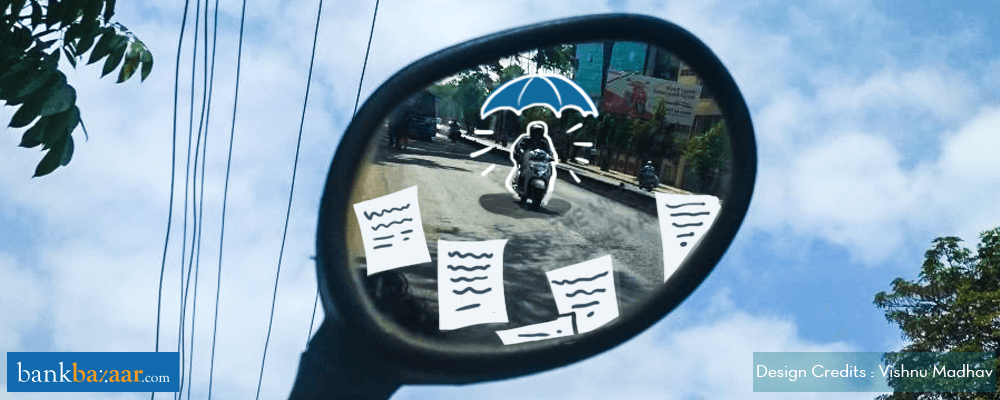‘Ride free’ may be a motto you live by, but tempting fate is never a good idea. Here’s what you need to know before purchasing a Two-Wheeler insurance policy online.

Just like Car Insurance for your four-wheeler, Two-Wheeler Insurance for your bike is really important. A comprehensive Two-Wheeler Insurance safeguards you against future emergencies or calamities. We’ll tell you how to go about applying for it here.
What is Two-Wheeler Insurance?
A Two-Wheeler Insurance policy is an insurance policy that offers cover against any damage that may occur to a motor cycle and/or its riders due to unforeseen events like an accident, theft or natural disaster. It provides protection against liabilities arising from injuries to one or more individuals due to an accident. A bike insurance provides cover to all types of two-wheelers: motor cycle, moped, etc. and includes all uses: personal, commercial or mixed.
What types of plans are available?
There are two types of Two-Wheeler Insurance plans that one can choose from:
-
Liability only plans:
A liability-only policy is a third party policy that covers the legal liability for injury, death, and/or property damage caused to a third party in the event of an accident caused by or arising out of the use of the vehicle. A liability-only plan does not cover damage to your vehicle.
-
Comprehensive plans:
A comprehensive plan offers cover against all types of wear and tear to the vehicle and its riders apart from bodily injury, death or damage to a third party and his or her property.
When one applies for a Two-Wheeler insurance, one gets a liability-only policy by default. One can choose to opt for a comprehensive policy in addition to one’s limited cover liability-only policy.
Personal accident cover:
Insurance policies like ICICI Lombard Two-Wheeler Insurance offers a Personal Accident (PA) cover that provides compensation on death/permanent total disablement and reimbursement of accidental hospitalisation expenses. One can also opt to cover the pillion passenger.
Additional reading: How To Avoid These Five Common Health Insurance Distress
What are the type of add-ons available?
Other than basic coverage, Two-Wheeler Insurance policies today offer a host of add-ons for the buyer to choose from:
- Zero Depreciation: When you file a claim, you will receive the full amount of damages, as there will be no deductions on account of depreciation of value of the vehicle parts.
- Garage Cash: Including Garage Cash add-on in your plan will take care of your daily commute expenses when your vehicle is in the garage for repairs.
- No Claims Bonus: This is an add-on that will reward you for being safe. If you do not file any claims in the term of your policy, you will be eligible for a no claims bonus at the time of policy renewal.
- Roadside Assistance: Avail roadside assistance in the event of towing, refuelling, flat tyre, minor repairs etc.
Additional reading: Stay Insured On Rail Travel With IRCTC’s Accidental Insurance
Factors that affect Two-Wheeler Insurance Premiums:
- Cubic capacity: There are three categories of cubic capacity as per the India Motor Tariff.
- 0-150 cc
- 150-350 cc
- 350 cc and above
An increase in cubic capacity would mean that your insurance premium would also be higher.
- Zone of purchase: Where you bought your bike plays an important role in deciding your Two Wheeler Insurance premium. Cities across India are divided into two different zones. The premium charged on vehicles in these two zones also vary.
Zone A includes cities like Ahmedabad, Bangalore, Chennai, Delhi, Hyderabad, Kolkata, Mumbai and Pune.
All other cities fall under Zone B.
The premium one has to pay for vehicles bought in Zone A is generally higher than that of those bought in Zone B cities.
Additional reading: All You Need To Know About TDS On Life Insurance Policies
What kind of cover should you opt for?
- Insured Declared Value (IDV): The age of the vehicle decides the Insured Declared Value of it. This is the amount for which your two-wheeler is insured. This value is calculated according to the selling price and depreciation based on the age of the vehicle.
- No Claim Bonus: Riders who haven’t claimed their Two-Wheeler Insurance for an entire year are eligible for a discount on their premium.
The least No Claim Bonus one can get on one’s Two-Wheeler Insurance is 20%. For every successive year, the NCB discount increases by 10% every year. The maximum limit on the discount is 50%.
There is a cap on third party claims:
One can claim third party damages up to Rs. 7, 50,000 (as provided by the Insurance Regulatory and Development Authority (IRDA)). If you want, you can choose to limit the cover to a minimum of Rs. 6,000. The actual amount of cover, however, will depend on your policy.
Change of ownership:
If you’ve made up your mind to sell off your two-wheeler at any point, you have the option of transferring your insurance plan to its new owner. All you need to do is to inform your insurer within 14 days of selling your vehicle.
Vehicle change:
Even if you buy a new bike, you can continue using your existing bike insurance. Remember that the insurance premium would be changed to pro-rata basis.
Uninsured rider cover:
As per the Motor Vehicle Act, it is mandatory for vehicle owners to have third-party cover. In spite of this, there are many vehicle owners who don’t have any third party cover. When you meet with an accident due to the negligence of a third party person who is uninsured, the uninsured rider coverage acts as a layer of protection to the third party.
A host of banks like ICICI, HDFC Ergo and National Insurance etc. offer a variety of Two-Wheeler Insurance plans.
Additional Reading: All You Need To Know About Third-Party Two-Wheeler Insurance
Not happy with your existing insurance plan? Find out more about the best Two-Wheeler Insurance plans.